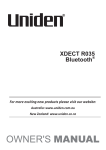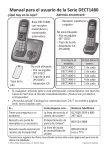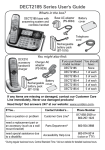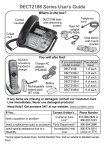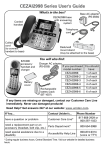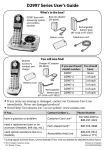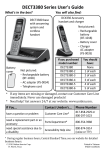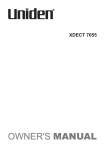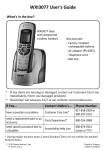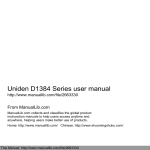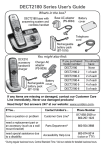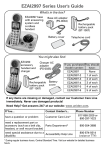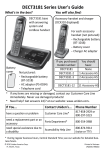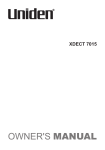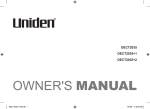Download Uniden DECT1480-2 User`s guide
Transcript
DECT1480 Series User's Guide
You will also find:
What's in the box?
DECT1480 base
with answering
system and
cordless
handset
Battery
cover
Not pictured:
- Rechargeable battery
(BT-1007)
- AC adapter (PS-0035)
- Telephone cord
Accessory handset
and charger
Not pictured:
- Rechargeable
battery (BT-1007)
- Battery cover
- AC adapter
(PS-0035)
If you purchased
model number:
DECT1480-2
DECT1480-3
DECT1480-4
DECT1480-5
DECT1480-6
You should
have:
1 of each
2 of each
3 of each
4 of each
5 of each
If any items are missing or damaged, contact our Customer Care Line
immediately. Never use damaged products!
Need help? Get answers 24/7 at our website: www.uniden.com.
If You...
Contact Uniden’s...
have a question or problem
Customer Care Line*
Phone Number
817-858-2929 or
800-297-1023
need a replacement part or an
Parts Department*
800-554-3988
accessory
need special assistance due to
800-874-9314
Accessibility Help Line
a disability
(voice or TTY)
* During regular business hours, Central Standard Time; see our website for
detailed business hours.
© 2009 Uniden America Corp.
Ft. Worth, Texas
Printed in China
UNZZ01107BZ(0)
What’s in the manual?
Answering System Options
Getting Started............................. 3
(Ans. Setup)............................. 15
Installing Your Phone................... 3
Accessing
the Answering
Getting to Know Your Phone....... 5
System..................................... 16
Using the Menu........................... 8
Personalizing the Greeting........ 17
Using Your Phone....................... 10
Getting Your Messages.............. 18
Basics......................................... 10
Using the System While You're
Using the Phonebook................ 12
Away from Home.................... 19
Finding a Lost Handset............... 13
Important Information............... 20
Using Special Features................ 13
Solving Problems....................... 20
Chain Dialing.............................. 13
AC Adapter and Battery
Multihandset Features.............. 13
Information............................. 23
Voice Message Notification....... 15
Compliance Information............ 24
Using the Answering System . .... 15
1-Year Limited Warranty........... 27
Important Safety Instructions!
When using your telephone equipment, basic safety precautions
should always be followed to reduce the risk of fire, electric shock and
injury to persons, including the following:
This unit is NOT waterproof. DO NOT expose this unit to rain or
moisture.
Do not use this product near water, for example, near a bath tub,
wash bowl, kitchen sink or laundry tub, in a wet basement or near a
swimming pool.
Avoid using a telephone (other than a cordless type) during an
electrical storm. There may be a remote risk of electric shock from
lightning.
Do not use the telephone to report a gas leak in the vicinity of the
leak.
Use only the power cord and batteries indicated in this manual. Do
not dispose of batteries in a fire. They may explode. Check with local
codes for possible special disposal instructions.
Do not place the handset in any charging cradle without the battery
installed and the battery cover securely in place.
SAVE THESE INSTRUCTIONS!
CAUTION! Risk of explosion if battery is replaced by an incorrect type!
Dispose of used batteries according to the instructions. Do not open
or mutilate the battery. Disconnect the battery before shipping this
product.
For more details, see the Important Information section.
Getting Started
Installing Your Phone
Charge the Battery
1. Unpack all handsets, battery packs,
and battery covers. If you need to
remove a battery cover, press in on
the notch and slide the cover down
and off.
2. Line up the battery connector with the jack inside the handset.
(The battery connector will only fit one way.)
. Push the connector in until it clicks into place; tug gently on the
wires to make sure the battery pack is securely connected.
4. Replace the battery cover and slide it into place.
. Connect the AC adapters to the AC IN 8V jacks on the base and on
each charger. Set the plugs into the notches.
. Plug the other end of the adapters into standard 120V AC outlets.
7. Place one handset in the base and the other(s) in the charger(s)
with the displays facing forward. The display on each handset
should light up; if it doesn’t, reseat the handset or try plugging the
AC adapter into a different outlet.
Charge all handsets completely (about 15 hours) before using
them.
Connect the Telephone Cord
Use the telephone cord to connect the TEL LINE jack on the base to a
standard telephone wall jack.
Test the Connection
1. Pick up the handset from the cradle and press Talk. You should
hear a dial tone, and the display should say Talk.
If you don't hear a dial tone or the display says Check Tel Line, try
checking the connection between the base and the phone jack.
2. Make a quick test call. (Press End to hang up.)
If you keep hearing a dial tone, try changing to pulse dialing mode.
If there is a lot of noise, see page 21 for tips on avoiding
interference.
. Test all your handsets the same way. If you can't get a dial tone, try
moving the handset closer to the base.
Changing from Tone to Pulse Dialing
Your phone communicates with the telephone network in two ways:
tone dialing or pulse dialing. Most telephone companies use tone
dialing. If your phone company uses pulse dialing, you will need to
change your phone’s dial mode.
1. From a handset, open the menu and select Global Setup. (See page
8 for details on using the menu.)
2. Select Dial Mode, then select Pulse. The phone sounds a
confirmation tone.
If you use pulse dialing and you need to send DTMF tones during a call
(if you're using an automated response system, for example), press
to temporarily switch to tone dialing. When the call ends, the phone
automatically returns to pulse dialing mode.
*
REV DOWN
FIND
DELETE
PLAY/ UP FWD
STOP
Charging ANSWERING
ON/OFF
SYSTEM
contacts
STATUS
Parts of the base
MESSAGES/
MUTE
REDIAL/
PAUSE
TALK/
FLASH
DOWN
CLEAR/
INTERCOM
PHONEBOOK/
LEFT
Display
Earpiece
Parts of the handset
Charging
contacts
Microphone
SPEAKER
Twelvekey dial
pad
END
MENU/
SELECT
CALLER ID/
RIGHT
UP
STATUS
Getting to Know Your Phone
Base keys/LEDs and how they work
Key (icon) What it does
- In standby: increase the ringer volume.
Up (+)
- While a message is playing: increase the speaker volume.
- In standby: decrease the ringer volume.
Down (–)
- While a message is playing: decrease the speaker volume.
FWD ( ) - While a message is playing: skip to the next message.
- While playing messages: for the first 2 seconds, go to
REV ( )
the previous message; after that: go to the start of the
current message.
- In standby: start playing messages.
Play/stop
- While a message is playing: stop playing messages.
(
)
- If the phone is ringing: mute the ringer for this call only.
On / OFF
- In standby: turn the answering system on or off.
- While a message is playing: delete this message.
Delete
( )
- In standby: delete all messages.
FinD
- In standby: page all handsets.
LED
What it means
- On: a message is playing.
PLAY/STOP
- Blinking: there are new messages.
- On: the answering machine is on.
Status
- Off: the answering machine is off.
- Blinking: the base is paging all handsets.
Handset keys/LEDs and how they work
Key (icon)
Clear/
intercom
Talk/flash
What it does
- In standby: start an intercom call.
- During a call: put the call on hold and start a call
transfer to another handset.
- While entering text: delete one character, or press
and hold to delete all the characters.
- In standby: start a telephone call (get a dial tone).
- During a call: switch to a waiting call.
Key (icon)
What it does
- During a call: hang up.
End
- In the menu or any list: exit and go to standby.
- In standby: open the menu.
Menu/select
- In the menu or any list: select the highlighted item.
- In standby: increase the ringer volume.
- During a call: increase the audio volume.
Up (
)
- In any menu or list: move the cursor up one line.
- In standby: decrease the ringer volume.
- During a call: decrease the audio volume.
Down ( )
- In any menu or list: move the cursor down one line.
- In standby or during a call: open the phonebook.
Phonebook/
- In the menu: go back to the previous screen.
left ( )
- During text entry: move the cursor to the left.
Caller ID/
- In standby or during a call: open the Caller ID list.
- During text entry: move the cursor to the right.
right ( )
- In standby: open the redial list.
Redial/
- While entering a phone number: insert a 2-second
pause
pause.
- In standby: access your answering system.
messages/
- During a call: mute the microphone.
mute (
)
- If the phone is ringing: mute the ringer for this call
only.
Speaker ( ) - Switch a normal call to the speakerphone (& back).
LED
What it means
- On: the battery is charging.
Status
- Blinking: there are new messages.
Reading the Display
This table shows possible status icons and what they mean. Since the
icons appear based on what you're doing with the phone, you won't
ever see all of these icons at the same time.
Icon
What it means
The ringer is turned off and will not ring for new calls.
You have a voice message waiting.
Privacy Mode is on: no other handset can join the call.
The speakerphone is on.
The microphone is muted; the caller can't hear you.
T-coil mode is on (see page 21).
[Aa] [aA]
The battery is 1) fully charged, 2) half charged, 3) getting
low, or 4) empty.
Enter 1) capital or 2) lower case letters (see page 9).
Using the Menu
To open the
menu, press
Press MENU/SELECT
to choose the
highlighted option.
MENU/SELECT.
The cursor
shows the
highlighted
option.
To move the
cursor, use
UP & DOWN.
<HANDSET SETUP>
T-coil
Ringer Tones
Handset Setup
Ans. Setup
Day & Time
To go back a
screen, press
OR
PHONEBOOK/LEFT
Handset Setup Menu
press END
to exit the
menu.
If you open the
menu during a call,
use LEFT to back out
of the menu without
hanging up.
If you don't press
any keys for about
thirty seconds, the
handset exits the
menu.
You can change these settings separately for each handset.
Turn on T-coil mode to reduce noise on some hearing
T-coil
aids (for more details, see page 21).
Choose this handset's ring tone. As you highlight each
Ringer Tones
ring tone, the phone plays a sample. When you hear
the tone you want, press Menu/select.
AutoTalk
Have this handset answer a call when you pick it up
from the cradle (without pressing any buttons).
Have this handset answer a call when you press any
key on the 12-key dialpad.
Change the name used on the handset's display.
Any Key
Answer
Banner
Handset
Change the display language.
Language
Key Touch Tone Have the keypad sound a tone when you press a key.
Ans Setup Menu
Refer to page 15 for details on setting up your answering system.
Day & Time Menu
Use this menu to set the clock manually. (If you have Caller ID, the
phone sets the day and time from the CID data.) Select the day of week,
then use the number keypad to enter the hour and minutes in HHMM
format (e.g., enter 0345 for 3:45). Then, select AM or PM.
Global Setup Menu
The settings on this menu affect all handsets. Only one handset at a
time can change these menu options.
Dial Mode
Set Line Mode
VMWI Reset
Change the way your phone communicates with the
telephone network (see page 4).
Do not change this setting unless instructed to by
customer service.
Reset your Visual Message Waiting Indicator to
bring it back in sync with your voice mail service.
Entering Text on Your Phone
Use the 12-key dial pad when you want to enter text into your phone
(a name in the phonebook, the handset banner, etc.).
The phone defaults to a capital letter for the first letter and any
letter after a space; otherwise, it uses small letters.
*
To switch to all capital letters, press . The phone defaults to all
capital letters first (e. g. ABCabc2) until you enter a blank space or
press again. (Any time you want to change case, just press .)
If two letters in a row use the same number key, enter the first letter
and wait a few seconds (or press RIGHT); the cursor will move to the
next space. Enter the next letter.
Press # to enter a blank space.
To change a letter, move the cursor to that letter and press CLEAR to
erase the letter. Then, enter the new one.
To erase the entire entry, press and hold CLEAR.
Press 0 to cycle through all available symbols and punctuation.
*
*
Using Your Phone
Basics
To...
make a call: Dial the
number, then
answer a call
hang up
switch between the
speaker & earpiece
mute the microphone
during a call
put a call on hold
return to a call on hold
mute the ringer for this
call only
Earpiece
Speakerphone
Press Talk/flash.
Press Speaker.
Press Talk/flash. Press Speaker.
Press End or put the handset in the cradle.
Press Speaker.
Press messages/mute. Press again to turn
the microphone back on.
Press Clear/intercom. After 5 minutes on
hold, the call will be disconnected.
Press Talk/flash. Press Speaker.
While the phone is ringing, press messages/
mute.
Changing the Volume
You can set speaker volume levels separately for the base and each
handset. You can also set the earpiece volume on each handset.
Anytime you are listening to a speaker or earpiece, press Up to
increase the volume and Down to decrease it.
10
You can also set the ringer volume separately: when the phone is in
standby, press Up to increase the ringer volume and Down to decrease.
If you turn the ringer volume all the way down, the ringer turns off.
Using the Caller ID and Redial Lists
Caller ID (CID) is a service available from your telephone provider
that shows the phone number (and sometimes the caller’s name) of
incoming calls. Contact your telephone provider for more information.
Caller ID list
Redial list
- When a call comes in, the phone displays the - Each handset
number and name (if available) of the caller.
remembers the
last 5 numbers
- The phone saves the information for the last
you dialed on it.
30 received calls to the CID list.
The redial list is
- When it’s in standby, the handset shows how
separate for each
many calls came in since the last time you
handset.
checked the CID list.
All handsets share the CID list; only one handset can access
the CID list at a time.
To…
Follow these steps:
Open the CID list
Press Caller ID/right.
Redial/pause.
Open the redial list
Scroll through the
Press DOWN to scroll from newest to oldest.
lists
Press UP to scroll from oldest to newest.
Dial a number from
Highlight the number you want and press Talk/
the lists
flash or speaker.*
Close the lists
Press Phonebook/left.
* If the number is a toll or long distance call, but there's no 1 at the front of
the CID record, press to add the 1 before dialing.
*
To select a number, highlight the number and press Menu/select. The
phone gives you the following options:
Delete Entry Erase the number from the list.
11
Store Into Pb
Delete All
Add the number to the phonebook. The handset prompts
you to edit the name and number.
(CID list only) Erase all numbers from the list.
Using Call Waiting
Call Waiting, a service available from your telephone provider, lets you
receive calls while you are on another call. Caller ID on Call Waiting
(CIDCW) service displays Caller ID information for a waiting call.
If you get a Call Waiting call, the phone sounds a tone and displays any
CID information received from the waiting call. Press Talk/flash to
switch between the current call and the waiting call; each time you
switch, there is a short pause before you're connected to the other call.
Using the Phonebook
The phone can store up to 70 entries in its phonebook. All handsets
share the same phonebook, so only one handset may access the
phonebook at a time.
To...
Press...
Open/close the phonebook Phonebook/left.
Scroll through the entries
Jump to entries that start
with a certain letter
Dial an entry
Down (to scroll through the phonebook
from A to Z) or Up (to scroll from Z to A).
the number key corresponding to the
letter you want.
Up or Down to find the entry you want to
dial, then press Talk/flash or Speaker.
Phonebook Menu Options
Open the phonebook with the phone in standby, then press Menu/
select to open the phonebook menu. Choose one of these options:
Create New
Delete All
12
Add an entry to your phonebook. The phone prompts you
to enter a name and number.
Erase all the entries in the phonebook.
If you need the phone to pause before sending the next set of digits,
press Redial/pause to insert a 2-second pause. The pause shows as a
P in the display.
You can insert as many pauses as you need, but each pause counts
as one of your 20 digits.
Phonebook Entry Options
With the phone in standby, open the phonebook and find the entry
you want. Press Menu/select to open the individual phonebook entry
menu. The phone prompts you to edit or delete the entry.
Finding a Lost Handset
With the phone in standby, press Find on the base. All the handsets will
beep in a 3-beep pattern for 1 minute or until you press Find again.
You can also end the page by pressing any key from the found handset.
Using Special Features
Chain Dialing
If you often have to enter a series of digits or a code number during a
call, you can save that code number to a phonebook entry and use the
phonebook to send the code number.
1. Enter the code number (up to 20 digits) into the phonebook just
like a regular phonebook entry. Be sure to enter the code number
into the phonebook exactly as you would enter it during a call.
2. When you hear the prompt that tells you to enter the number,
open the phonebook and find the entry that contains your code
number. Press Menu/select to transmit the code. The phone
transmits the code number entered in the previous step. If you
change your mind, use Phonebook/left to close the phonebook.
Multihandset Features
Conference Calling
When an outside call comes in, two handsets can join in a conference
call with the outside caller.
13
To join the call, just press Talk/flash or Speaker.
To leave the conference call, hang up normally; the other handset
remains connected to the call.
Privacy Mode
To prevent other handsets from joining a call:
1. Start your call as usual, then press Menu/select. The display shows
Call Privacy.
2. Press Menu/select again to turn privacy mode on (you'll see a in
the display).
Privacy mode turns off automatically when you hang up.
As long you have privacy mode on, no other handsets can
interrupt your call. To accept another handset in the call, turn
privacy mode off by repeating the process above (press Menu/
select twice).
Intercom
Whenever the phone is in standby, you can make an intercom call
between handsets without using the phone line.
You can make an intercom call from any handset, but only two
handsets can be in an intercom call at any time.
If an outside call comes in during an intercom page, the phone
cancels the page so you can answer the incoming call.
If an outside call comes in during an intercom call, press Talk/flash
to hang up the intercom call and answer the outside call.
To...
make an intercom
page
cancel a page
answer a page
end an intercom call
14
Follow these steps:
1. Press Clear/intercom.
2. Select the handset you want to talk with, or
All to page all handsets at the same time.
Press End.
Press Clear/intercom or Talk/flash.
Press End. Both handsets return to standby.
Call Transfer
To...
Follow these steps:
1. Press Clear/intercom to put the call on hold.
2. Select the handset you want to page (select All to
transfer a call
page all handsets at the same time).
3. When another handset accepts the call, you'll be
disconnected (press Talk/flash to rejoin the call).
cancel a transfer Press Talk/flash to return to the call.
1. To answer the page and speak to the transferring
accept a
handset using the intercom, press Clear/intercom.
transferred call
2. To speak to the outside caller, press Talk/flash.
Voice Message Notification
If you subscribe to a voice mail service, your phone can notify
you when you have a new message waiting. This feature supports
Frequency-Shift Keying (FSK) message notification. Contact your
voice mail provider for information.
When you have new messages, the voice message icon appears in
the display, and the Status light on the handset blinks.
After you listen to your messages, the voice message icon turns off.
If it doesn’t, you can reset it: With the phone in standby, open the
menu and select Global Setup; select VMWI Reset, then select Yes.
Using the Answering System
Answering System Options (Ans. Setup)
You can set or change the answering system options from any handset.
Just open the menu and select Ans. Setup. Select one of the following:
Security Code
Ring Time
Enter a 2-digit PIN so you can access your answering
system from any touch-tone phone (see page 19).
Set the number of rings (2, 4, or 6) before the answering
system answers the phone. Choose Toll Saver to
have the system pick up after 2 rings if you have new
messages or after 4 rings if you don't.
15
Record Time
Message
Alert
Ans.
Language
Call Screen
Ans. On/off
Set the amount of time (1 or 4 minutes) callers have to
leave a message. Choose Announce Only if you don't
want the system to let callers to leave a message.
Have the system beep every 15 seconds when you have
a new message; the beeping stops when you listen to all
your new messages. (To mute the alert without listening
to your messages, press any key on the base.)
Change the language of the system's voice prompts.
Turn on the call screen feature so you can hear callers as
they leave messages on the base speaker (see page 18).
Turn your answering system on or off. (To turn your
system on or off from the base, just press On/off.)
Accessing the Answering System
You can access your system from a handset whenever the phone is in
standby.
Press MESSAGES/MUTE to start
remote operation mode.
Use PHONEBOOK/
LEFT to go to the
previous option:
4:Delete
3:Skip
2:Play
1:Repeat
5:Stop
[ / /select]
Use CALLER ID/
RIGHT to go to the
next option:
6:SelectGreeting
8:RecNewGreeting
Press MENU/
SELECT to choose
the displayed option.
Press END to
exit remote
operation mode.
During remote operation, the phone beeps to let you know it's
waiting for your next command.
You can press the number key next to the commands instead of
scrolling through them.
16
If you take no action for 30 seconds, the phone returns to standby.
Only one handset can access the system at a time.
Personalizing the Greeting
Your personal outgoing message or greeting can be between 3
seconds and 30 seconds long.
If you don't want to record a greeting, the system uses a prerecorded greeting: Hello, no one is available to take your call. Please
leave a message after the tone.
After you record a greeting, you can switch between the prerecorded greeting to your personal greeting at any time.
Record a Personal Greeting
1. Access the answering system from any handset. Wait until the
system finishes its announcements, or press 5 (Stop) to skip them.
2. Press 8 (RecNewGreeting).
. Wait for the system to say "Record greeting," then begin speaking.
4. When you're finished, press 8 to stop recording. The system plays
back your new greeting.
. To keep this greeting, press End. To re-record it, go back to step 2.
Switch Between the Two Greetings
1. Access the answering system from any handset. Wait until the
system finishes its announcements or press 5 (Stop) to skip them.
2. Press 6 (SelectGreeting) to play back the current greeting.
. Press 6 again to switch greetings.
Delete Your Greeting
Switch to your personal greeting following the steps above, then press
4 (Delete) while the system is playing back your greeting.
17
Getting Your Messages
From a handset
(remote operation)
Press Play/stop.
Press Messages/mute.
The system announces the number of new and old
play new
messages, then plays each new message (followed by
messages
the time and date) in the order it was received.
replay an earlier
Within 2 seconds after a message starts playing,
press REV.
select 1:Repeat.
message
Wait at least 5 seconds
Wait at least 3 seconds after
restart the
after a message starts
a message starts playing,
current message
playing, then select 1:
then press REV.
Repeat.
skip a message Press FWD.
Select 3:Skip.
delete a
While the message is playing, While the message is
message
press Delete.
playing, Select 4:Delete.
With the phone in standby,
delete all of
press Delete. When
Not available.
your messages
prompted, press Delete again.
After the system plays all new messages,
play old
messages
press Play/stop again.
Select 2:Play.
stop playback press Play/stop.
Select 5:Stop.
To...
From the base
Screening Your Calls
Another feature your answering system gives you is call screening.
While the system is taking a message, you can hear the caller on the
base speaker (if you turn on Call Screen) or from a handset. Only one
handset at a time can screen calls. If another handset tries to screen
the call, the second handset beeps and returns to standby.
To...
hear the caller leaving
a message
18
From the base
Listen to the caller
over the speaker.
From a handset
Press Messages/mute.
To...
From the base
From a handset
answer the call
NA
Press Talk/flash.
mute the call screen
Press End or return the
Press Play/stop.
without answering*
handset to the cradle.
* If you mute the call screen, the system continues taking the message: it just
stops playing through the speaker.
Using the System While You're Away from Home
You can also use your answering system from any touch-tone phone.
Before you can use this feature, you must program a security code.
Programming a security code
1. With the phone in standby, open the menu from any handset.
2. Select Ans. Setup, then select Security Code.
. Use the number keypad to enter a two-digit security code (01 to
99). Press Menu/select when you’re finished.
Remember to make a note of your new security code!
Dialing In to Your System
1. Call your telephone number and wait for the system to answer.
(If your answering system is off, it will answer after ten rings and
sound a series of beeps instead of your greeting.)
2. During the greeting or beeps, press 0 and immediately enter your
security code. If you enter it incorrectly 3 times, the system hangs
up and returns to standby.
. The system announces the current time, the number of messages
stored in memory, and a help prompt. It will beep intermittently to
let you know it's waiting for your command.
4. When you
01 Repeat message
05 Stop playback
hear beeping,
02
Play
message
06 Turn the system on
enter a 2-digit
09 Turn the system off
command from 03 Skip message
04 Delete message
10 Hear help prompts
this chart:
19
If you don't press any keys for 15 seconds, the system hangs
up and return to standby.
Important Information
Solving Problems
If you have any trouble with your phone, try these simple steps first. If
you need help, call our Customer Care Line listed on the front cover.
If…
Try…
- Checking the telephone cord connection.
No handsets can make - Disconnecting the base AC adapter. Wait a
few minutes, then reconnect it.
or receive calls.
- Making sure the base is plugged in.
A handset can’t make
- Moving the handset closer to the base.
or receive calls.
A handset can make
- Making sure the ringer is turned on.
calls, but it won’t ring.
- Charging the battery for 15-20 hours.
A handset is not
working.
- Checking the battery connection.
- Moving the handset closer to the base.
A handset says
Unavailable.
- Seeing if another handset is in Privacy Mode.
- Letting calls ring twice before answering.
No handsets display
Caller ID information. - Making sure your Caller ID service is active.
Caller ID displays
- You may have to change the line mode.
Contact Customer Service for instructions.
briefly & then clears.
- You may have to reset the handset. Contact
I can’t transfer calls.
Customer Service for instructions.
Two handsets can’t
- Making sure no handset is in Privacy Mode.
talk to the caller.
The answering system - Making sure the answering system is on.
does not work.
- Making sure the base is plugged in.
20
If…
Try…
- Making sure the Record Time is not set to
The system won't
Announce Only.
record messages.
- Deleting messages (memory may be full).
A handset can't access - Seeing if another handset is using the system.
the answering system. - Making sure the phone is in standby.
- If there was a power failure, you may
My outgoing message
have to re-record your personal outgoing
is gone.
message.
I can’t hear the base - Making sure call screening is turned on.
speaker.
- Changing the base speaker volume.
- The incoming messages may be too long.
Messages are
Remind callers to leave a brief message.
incomplete.
- Deleting messages (memory may be full).
When I answer on an
extension, the phone - You may have to change the line mode.
Contact Customer Service for instructions
keeps ringing (or
keeps recording.)
Weak or Hard To Hear Audio
If a caller’s voice sounds weak or
soft, the signal might be blocked
by large metal objects or walls;
you might also be too far from
the base, or the handset’s battery
may be weak.
Try moving around while
you’re on a call or moving
closer to the base to see if the
sound gets louder.
Make sure the handset’s
battery is fully charged.
Try adjusting the earpiece
volume.
Do you use a T-Coil hearing aid?
• If you have a hearing aid equipped
with a telecoil (T-coil) feature, the
interaction between the hearing aid
& digital cordless phones can cause
noise in the handset. If you have a Tcoil hearing aid & you have problems
with noise on the line, try turning on
T-coil mode. Open the menu. Select
Handset Setup, then select T-coil.
• Using T-coil mode can shorten the
handset’s talk time; make sure to
watch the battery status and keep
the battery charged.
21
N���������������������������
oise or Static on the Line
Interference is the most common cause of noise or static on a cordless
phone. Here are some common sources of interference:
electrical appliances, especially microwave ovens
computer equipment, especially wireless LAN equipment and DSL
modems
radio-based wireless devices, such as room monitors, wireless
controllers, or wireless headphones or speakers
fluorescent light fixtures (especially if giving off a buzzing noise)
other services that use your phone line, like alarm systems,
intercom systems, or broadband Internet service
If static is on 1 handset or in 1
location:
- Check nearby for one of the
common interference sources.
- Try moving the handset away
from a suspected source, or try
moving the suspected source so
it’s not between the handset and
the base.
- There is always more noise at
the edges of the base's range.
If an Out of Range message
displays, try moving closer to the
base.
If static is on all handsets or in all
locations:
- Check near the base for the
source of interference.
- Try moving the base away
from a suspected source, or
turn off the source if possible.
- If the base has an adjustable
antenna, try raising the
antenna so it stands straight
up.
- If you have any service that
uses the phone line, you might
need a filter (see below).
Installing a Line Filter or DSL Filter
Sometimes, broadband Internet services that use the telephone line
can interfere with phones. One of these services−DSL−often causes
static on telephones. A DSL filter or telephone line filter usually solves
this problem. The technician who installed your DSL service might
have left some filters for you; if not, call your DSL provider or look in
any electronics store.
22
Plug the DSL filter into the telephone wall jack and plug your phone’s
base into the filter. Make a test call to make sure the noise is gone.
Liquid Damage
Moisture and liquid can damage your cordless phone.
If the exterior housing of the handset or base is exposed to moisture
or liquid, wipe off the liquid, and use as normal.
If moisture or liquid is inside the plastic housing (i.e. liquid can
be heard in the phone or liquid has entered the handset battery
compartment or vent openings on the base), follow these steps:
Handset
Base
1. Disconnect the AC
1. Remove the battery cover and disconnect
adapter to cut off
the battery.
the power.
2. Let dry for at least 3 days with the battery
2. Disconnect the
disconnected and the cover off.
telephone cord.
3. After the handset dries, reconnect the
3. Let dry for at least
battery and replace the cover. Recharge the
3 days before
battery fully (15-20 hours) before using.
reconnecting.
CAUTION! DO NOT use a microwave oven to speed up the
drying process. This will cause permanent damage to the
handset, base and the microwave oven.
AC Adapter and Battery Information
• Use only the supplied AC adapters. Be sure to use the proper adapter for the
base & any chargers.
• Do not place the power cord where it creates a trip hazard or where it could
become chafed and create a
Base/Charger
fire or electrical hazard.
Part
number
PS-0035
• Do not place the unit in direct AC
adapter
Input
voltage
120V AC, 60 Hz
sunlight or subject it to high
temperatures.
Output voltage 8V AC @ 300mA
• Fully charged, the battery
Part number
BT-1007
Battery
should provide about 10
pack
Capacity
500mAh, 2.4V DC
hours of talk time and about 7
23
days of standby time. For best results,
return the handset to the cradle after
each call to keep it fully charged.
• When the battery gets too low, the
handset shows a low battery alert. If
you hear a strange beep during a call,
check the display: if you see the low
battery alert, finish your conversation
as quickly as possible and return the
handset to the cradle. If the handset
is in standby, none of the keys will
operate.
• With normal use, the battery should
last about one year. Replace the battery when the talk time becomes short
even when the battery is charged. To
buy a replacement battery, call the
Parts Department listed on the front
cover.
Rechargeable Nickel-Cadmium
Battery Warning
• This equipment contains a rechargeable Nickel-Cadmium (Ni-Cd) battery.
• Cadmium and Nickel are chemicals
known to the State of California to
cause cancer.
• Do not short-circuit the battery.
• The rechargeable Ni-Cd batteries contained in this equipment may explode
if disposed of in a fire.
• Do not charge the battery used in
this equipment in any charger other
than the one designed to charge this
battery as specified in the owner's
manual. Using another charger may
damage the battery or cause it to
explode.
• As part of our commitment to
protecting our environment and
conserving natural resources, Uniden
voluntarily participates in an RBRC®
industry program to collect and
recycle used Ni-Cd batteries within the
United States. Please call 1-800-8-BATTERY for information on Ni-Cd battery
recycling in your area.
(RBRC® is a registered
trademark of the
Rechargeable Battery
Recycling Corporation.)
Rechargeable batteries must be
recycled or disposed of properly.
Uniden works to reduce lead
content in PVC coated cords in
our products & accessories.
Warning! The cords on this
product and/or accessories
contain lead, a chemical known
to the State of California to
cause birth defects or other
reproductive harm. Wash hands
after handling.
Compliance Information
FCC Part 68 information
This equipment complies with Part
68 of the FCC rules and the requirements adopted by the ACTA. On the
bottom of this equipment is a label
that contains, among other information, a product identifier in the format
US: AAAEQ##TXXXX. If requested,
this number must be provided to the
phone company.
An applicable Universal Service Order
Codes (USOC) certification for the jacks
used in this equipment is provided
(i.e., RJ11C) in the packaging with each
piece of approved terminal equipment.
A plug and jack used to connect this
equipment to the premises wiring and
telephone network must comply with
the applicable FCC Part 68 rules and
requirements adopted by the ACTA. A
compliant telephone cord and modular
plug is provided with this product. It is
designed to be connected to a compatible modular jack that is also compliant.
See installation instructions for details.
The REN is used to determine the
number of devices that may be connected to a phone line. Excessive RENs
on a phone line may result in devices
not ringing in response to an incoming
call. In most but not all areas, the sum
of RENs should not exceed five (5.0).
To be certain of the number of devices
that may be connected to a line, as
determined by the total RENs, contact
the telephone provider. The REN for
this product is part of the product
identifier that has the format US:
AAAEQ##TXXXX. The digits represented
by ## are the REN without a decimal
point (e.g., 03 is a REN of 0.3).
If this equipment causes harm to the
telephone network, the telephone
company will notify you in advance
that temporary discontinuance of service may be required. But if advance
notice isn't practical, the telephone
company will notify the customer as
soon as possible. Also, you will be
advised of your right to file a complaint with the FCC if you believe it is
necessary. The telephone company
may make changes in its facilities,
equipment, operations or procedures
that could affect the operation of
the equipment. If this happens the
telephone company will provide advance notice in order for you to make
necessary modifications to maintain
uninterrupted service.
Please follow instructions for repairing, if any (e.g. battery replacement
section); otherwise do not substitute
or repair any parts of the device
except as specified in this manual.
Connection to party line service is
subject to state tariffs. Contact the
state public utility commission, public
service commission or corporation
commission for information. This
equipment is hearing aid compatible.
If you experience trouble with this
equipment, contact the manufacturer
(see the cover of this manual for
contact information) or an authorized
agent. If the equipment is causing
harm to the telephone network, the
telephone company may request that
you disconnect the equipment until
the problem is resolved.
If your home has wired alarm equipment connected to a phone line, be
sure that installing the system does
not disable your alarm equipment. If
you have questions about what will
disable alarm equipment, contact your
telephone company or a qualified
installer.
Any changes or modifications to this
product not expressly approved by the
manufacturer or other party responsible
for compliance could void your authority
to operate this product.
NOTICE: According to telephone
company reports, AC electrical surges,
typically resulting from lightning
strikes, are very destructive to telephone equipment connected to AC
power sources. To minimize damage
from these types of surges, a surge
arrestor is recommended.
FCC Part 15 information
This device complies with part 15 of
the FCC rules. Operation is subject
to the following two conditions: (1)
This device may not cause harmful
interference, and (2) This device must
accept any interference received,
including interference that may
cause undesired operation. Privacy of
communications may not be ensured
when using this phone.
FCC PART 15.105(b): Note: This
equipment has been tested and
found to comply with the limits for
a Class B digital device, pursuant to
part 15 of the FCC Rules. These limits
are designed to provide reasonable
protection against harmful interference in a residential installation.
This equipment generates, uses and
can radiate radio frequency energy
and, if not installed and used in accordance with the instructions, may
cause harmful interference to radio
communications. However, there is
no guarantee that interference will
not occur in a particular installation.
If this equipment does cause harmful
interference to radio or television
reception, which can be determined
by turning the equipment off and on,
the user is encouraged to try to correct the interference by one or more
of the following measures:
• Reorient or relocate the receiving
antenna.
• Increase the separation between the
equipment and receiver.
• Connect the equipment into an outlet
on a circuit different from that to
which the receiver is connected.
• Consult the dealer or an experienced
radio/TV technician for help.
FCC RF Exposure Information
This product complies with FCC
radiation exposure limits under the
following conditions:
• The base must be placed to allow a
minimum of 20 cm (8 inches) between
the antenna and all persons during
normal operation.
• The base must not be collocated or
operated in conjunction with any
other antenna or transmitter.
• The handset is designed for bodyworn operation and meets FCC RF
exposure guidelines when used with
any belt clip, carrying case, or other
accessory supplied with this product.
(All necessary accessories are included
in the package; any additional or optional accessories are not required for
compliance with the guidelines.) Third
party accessories (unless approved by
the manufacturer) should be avoided
as these might not comply with FCC RF
exposure guidelines.
Industry Canada (I.C.) Notice
Terminal equipment
NOTICE: This equipment meets the
applicable ��������������������������
Industry Canada Terminal
Equipment Technical Specifications.
This is confirmed by the registration
number. The abbreviation IC before
the registration number signifies that
registration was performed based on
a Declaration of Conformity indicating that Industry Canada technical
specifications were met. It does not
imply that Industry Canada approved
the equipment.
NOTICE: The Ringer Equivalence Number (REN) for this terminal equipment
is marked on the equipment itself.
The REN assigned to each terminal
equipment provides an indication
of the maximum number of terminals allowed to be connected to a
telephone interface. The termination
on an interface may consist of any
combination of devices subject only to
the requirement that the sum of the
Ringer Equivalence Numbers of all the
devices does not exceed 5.
Radio equipment
The term IC before the radio certification number only signifies that Industry Canada technical specifications
were met. Operation is subject to
the following two conditions: (1) this
device may not cause interference,
and (2) this device must accept any
interference, including interference
that may cause undesired operation
of the device. "Privacy of communica-
tions may not be ensured when using
this telephone".
1-Year Limited Warranty
Evidence of original purchase is
required for warranty service.
WARRANTOR: UNIDEN AMERICA
CORPORATION ("Uniden")
ELEMENTS OF WARRANTY: Uniden
warrants, for one year, to the original
retail owner, this Uniden Product to
be free from defects in materials and
craftsmanship with only the limitations
or exclusions set out below.
WARRANTY DURATION: This warranty
to the original user shall terminate
and be of no further effect 12 months
after the date of original retail sale.
The warranty is invalid if the Product
is (A) damaged or not maintained as
reasonable or necessary, (B) modified, altered, or used as part of any
conversion kits, subassemblies, or any
configurations not sold by Uniden, (C)
improperly installed, (D) serviced or
repaired by someone other than an
authorized Uniden service center for a
defect or malfunction covered by this
warranty, (E) used in any conjunction
with equipment or parts or as part of
any system not manufactured by Uniden, or (F) installed or programmed
by anyone other than as detailed by
the owner's manual for this product.
STATEMENT OF REMEDY: In the event
that the product does not conform to
this warranty at any time while this
warranty is in effect, warrantor will
either, at its option, repair or replace
the defective unit and return it to you
without charge for parts, service, or
any other cost (except shipping and
handling) incurred by warrantor or its
representatives in connection with
the performance of this warranty.
Warrantor, at its option, may replace
the unit with a new or refurbished
unit. THE LIMITED WARRANTY SET
FORTH ABOVE IS THE SOLE AND
ENTIRE WARRANTY PERTAINING TO
THE PRODUCT AND IS IN LIEU OF AND
EXCLUDES ALL OTHER WARRANTIES OF
ANY NATURE WHATSOEVER, WHETHER
EXPRESS, IMPLIED OR ARISING BY OPERATION OF LAW, INCLUDING, BUT NOT
LIMITED TO ANY IMPLIED WARRANTIES
OF MERCHANTABILITY OR FITNESS FOR
A PARTICULAR PURPOSE. THIS WARRANTY DOES NOT COVER OR PROVIDE
FOR THE REIMBURSEMENT OR PAYMENT OF INCIDENTAL OR CONSEQUENTIAL DAMAGES. Some states do not
allow this exclusion or limitation of
incidental or consequential damages
so the above limitation or exclusion
may not apply to you.
LEGAL REMEDIES: This warranty gives
you specific legal rights, and you may
also have other rights which vary
from state to state. This warranty
is void outside the United States of
America and Canada.
PROCEDURE FOR OBTAINING PERFORMANCE OF WARRANTY: If, after following the instructions in the owner's
manual you are certain that the
Product is defective, pack the Product
carefully (preferably in its original
packaging). Disconnect the battery
from the Product and separately
secure the battery in its own separate
packaging within the shipping carton.
The Product should include all parts
and accessories originally packaged
with the Product. Include evidence of
original purchase and a note describing the defect that has caused you
to return it. The Product should be
shipped freight prepaid, by traceable
means, to warrantor at:
Uniden America Service
4700 Amon Carter Blvd.
Fort Worth, TX 76155
As an Energy Star®
Partner, Uniden has
determined that this
product meets the Energy
Star® guidelines for
energy efficiency. Energy Star® is a
U.S. registered mark.
• Uniden® is a registered trademark of
Uniden America Corporation.
• The pictures in this manual are for
example only. Your phone may not
look exactly like the pictures.
May be covered under one or more of the
following U.S. patents:
7,206,403 7,310,398 7,460,663
Other patents pending.




























